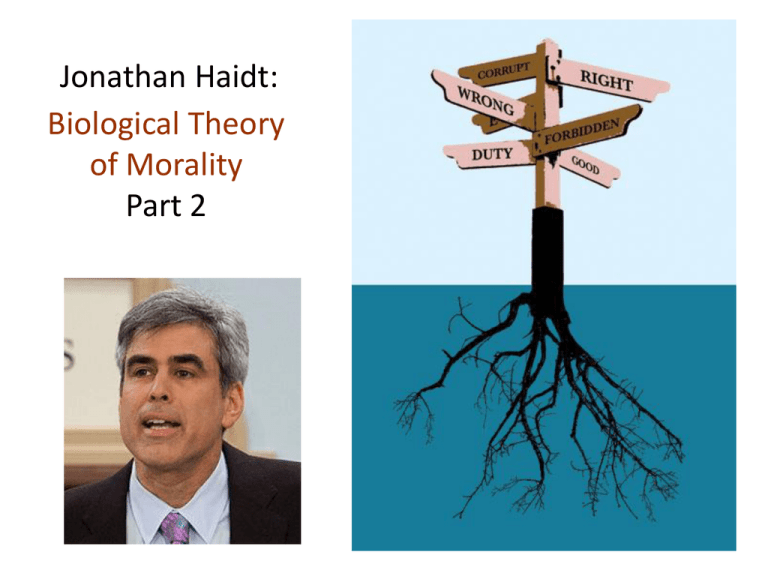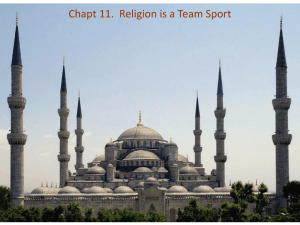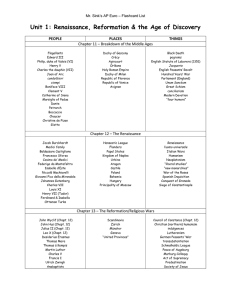EP Haidt 10
advertisement

Jonathan Haidt: Biological Theory of Morality Part 2 Chapt 10. The Hive Switch Muscular bonding Communal effort in battle high point of many veterans’ lives. “I passes insensibly into we” (McNeill) The Macedonian phalanx Haidt’s Hive hypothesis: “Human beings are conditional hive creatures. We have the ability (under special conditions) to transcend self-interest and lose ourselves (temporarily and ecstatically) in something larger than ourselves … The hive switch is an adaptation for making groups more cohesive, and therefore more successful in competition with other groups”. Chapt 10. The Hive Switch Barbara Ehrenreich: “Dancing in the Streets: A History of Collective Joy” Emile Durkheim: Criticized Freud (and others) “who tried to explain morality and religions using only the psychology of individuals (God is just a Father Figure said Freud). Durkheim argued, in contrast, that Homo sapiens was really Homo duplex, a creature who exists at two levels: as an individual and as a part of the larger society.” Ways to Flip the Hive Switch 1. Awe in nature 2. Drugs (‘Durkheimogens’) 3. Raves (Dances etc.) …and waiting in the wings: Religion! Chapt 10. The Hive Switch Aztec mushroom eater, about to be whisked away to realm of the sacred “All of a sudden I felt sort of drawn out into infinity, and all of a sudden I had lost touch with my mind. I felt that I was caught up in the vastness of Creation…Sometimes you would look up and see the light on the altar and it would just be a blinding sort of light and radiations…We took such an infinitesimal amount of psilocybin, and yet it connected me to infinity”. subject quoted by Rick Doblin Chapt 10. The Hive Switch Biology of the Hive Switch Oxytocin! Mirror Neurons Hives at Work Transactional vs Transformative Leadership Recommendations for your business: • Increase similarity, not diversity (uniforms!) • Exploit synchrony (e.g., Toyota) • Create healthy competition among teams, not individuals Chapt 10. The Hive Switch Emile Durkheim: We live most of our lives in the ordinary (profane) world, but we achieve our greatest joys in those brief moments of transit to the sacred world, in which we become ‘simply a part of the a whole” JFK: “Ask not what your country can do for you, ask what you can do for your country”. Haidt: It would be nice to believe that we humans were designed to love everyone unconditionally. Nice, but rather unlikely from an evolutionary perspective. Parochial love – love within groups – amplified by similarities, a sense of shared fate, and the suppression of free riders, may be the most we can accomplish. Chapt 11. Religion is a Team Sport Chapt 11. Religion is a Team Sport Common viewpoint among some scientists: all religions are delusions that prevent people from embracing science, secularism, and modernity. The attacks of 9/11 turned out to be a stimulus to explicit discussion of this topic. New Atheism: • Sam Harris: The End of Faith: Religion, Terror, and the Future of Reason (2004) • Richard Dawkins: The God Delusion (2006) • Daniel Dennett: Breaking the Spell: Religion as a Natural Phenomenon (2006) • Christopher Hitchens: God is Not Great: How Religion Poisons Everything (2007) Harris, Dawkins and Dennett “claimed to speak for science and to exemplify the values of science—particularly its open-mindedness and its insistence that claims be grounded in reason and empirical evidence, not faith and emotion”. Chapt 11. Religion is a Team Sport Harris: • “Throughout this book, I am criticizing faith in its ordinary, scriptural sense – as belief in, and life orientation toward, certain historical and metaphysical propositions”. • “A belief is a lever that, once pulled, moves almost everything else in a person’s life”. Harris, Dawkins, and Dennett all take religion to be a set of beliefs about supernatural agents. The New Atheist model of religious psychology e.g., the belief that martyrs will be rewarded with 72 virgins in heaven causes a man to undertake a suicide attack Chapt 11. Religion is a Team Sport The New Atheist model of religious psychology The Durkheimian model of religious psychology Chapt 11. Religion is a Team Sport The New Atheist model of religious psychology “The New Atheist model is based on the Platonic rationalist view of the mind … Reason is (or at least could be) the charioteer guiding the passions (horses). So long as reason has the proper factual beliefs (and has control of the unruly passions), the chariot will go in the right direction … [but, Haidt asks] to understand the psychology of religion, should we focus on the false beliefs and faulty reasoning of individual believers? Or should we focus on the automatic (intuitive) processes of people embedded in social groups that are striving to create a moral community? That depends on what we think religion is, and where we think it comes from”. Chapt 11. Religion is a Team Sport All known human groups have religion in some form. So from an evolutionary view, how do we explain the existence of religion? According to Haidt, either you grant that religiosity is beneficial OR you “construct a complicated multistep explanation of how humans in all known cultures came to swim against the tide of adaptation and do so much self-destructive religious stuff. The New Atheists choose the latter course”. Step 1: Hypersensitive agency detection device (e.g., we see faces in clouds, but never clouds in faces) – all mistakes in ‘false positive’ direction. Detector tuned to maximize survival, not accuracy. Add in shared intentionality and story-telling and pretty soon we get the birth of supernatural agents. Belief in gods is a by-product. ‘Gullible learning’ module (Dawkins) = believe what your parents tell you. All these modules in place 50,000 years ago. No natural selection (genetic selection) in response to selection pressures either for or against religiosity since then. Step 2: Cultural evolution Chapt 11. Religion is a Team Sport Step 2: Cultural evolution. Race is on. But race not by people or genes, but by memes. Religions are ‘heritable’, they ‘mutate’, and they are selected. Some memes are better than others at highjacking the human mind. (Dawkins religious memes ≈ virus, Dennett memes ≈ parasite). But other scientists (e.g., Atran, Heinrich) think that religion may be adaptive for individuals and/or groups. Like Durkheim, they believe that religions are sets of cultural innovations that spread to the extent that they make groups more cohesive and cooperative. Driven largely by completion among groups. But this is pure cultural evolution: religions evolve, not peoples or their genes. As groups take up agriculture and grow larger, their gods become far more moralistic. Gods of larger societies are usually quite concerned about actions that foment conflict and division with the group. They are used to promote cooperation within the group. Chapt 11. Religion is a Team Sport General function of Gods: to create a moral community. If the gods evolve (culturally) to condemn selfish and divisive behaviors, they can then be used to promote cooperation and trust within the group. People behave less ethically when they think no one can see them. But if the Gods are always watching… When people think that God can see them, and will punish them, they are much less likely to cheat, steal, commit adultery, etc. Gods that administer collective punishment (on the group) are much more effective at motivating group members to police individuals (gossip etc.). Chapt 11. Religion is a Team Sport Sosis & Bressler (2003) – compared religious and secular communes Chapt 11. Religion is a Team Sport Costly sacrifices best predictor of long-term success for religious communes, not for secular communes. Need to sacrilize the costly sacrifices. Chapt 11. Religion is a Team Sport Haidt thinks this is (biological) group selection, Atran & Henrich think it is pure cultural selection (moralistic gods are too recent, in last 10,000 years). They say religions evolve, not peoples or their genes. • If Haidt is right, we have been becoming more religious! • An adaptation that benefits individuals in the group context, e.g., by making the individual more cooperative, can be called a “group adaptation” but that does NOT make it a group-selected adaptation • Likewise, genes for religiosity (or a related trait) could have continued to evolve over the last 10-50,000 years but that process is not automatically group selection because it benefits the group • We invoke group selection only if the trait is genetically based AND is costly to the individual so that group selection and gene (individual) level selection are operating in opposite directions. Chapt 11. Religion is a Team Sport David Sloan Wilson Chapt 11. Religion is a Team Sport D. S. Wilson 2005: three four evolutionary hypotheses about religion • “For example, a social behavior can evolve by either within-group selection (increasing the fitness of the individual relative to others in its same group) or by between-group selection (increasing the fitness of the group relative to other groups in the total population)”. • “Perhaps it was adaptive in past environments but failed to keep pace with environmental change”. • “Perhaps it is a costly by-product of another trait that is a product of natural selection”. Chapt 11. Religion is a Team Sport D. S. Wilson 2005 …a social behavior can evolve by either within-group selection (increasing the fitness of the individual relative to others in its same group) or by between-group selection (increasing the fitness of the group relative to other groups in the total population). D. S. Wilson Question: What are the conflicting moral foundations in Shakespeare’s “The Taming of the Shrew”? Kate is very hungry but Petruchio won’t give her any of his KFC! David Quicksall & Kelly Kitchens in Seattle Shakespeare’s “trailer park” version of the Shrew More Questions 1. In his final chapter, Haidt presents Muller as a reasonable conservative (and based on my minimal reading of Muller so far, I would agree). However, here is the question someone else has asked about Muller: “ [Muller] is unable to contest the claim that conservative arguments are simply made in bad faith in order to defend existing power structures”. What is the author saying here? Do you have any idea how one could distinguish good-faith from bad-faith arguments? 2. In the last election, Todd Akin, Missouri’s Republican Senate candidate, claimed that victims of “legitimate rape” very rarely get pregnant because their bodies “have a way of shutting the whole thing down”: http://www.politico.com/news/stories/0812/79864.html First, what is the evidence that conception following rape is less (or more) likely? (You may have to google this up!) Second, how would Haidt describe Akin’s statements about rape? 3. What do you suppose is the function of Confession in the Catholic religion?










